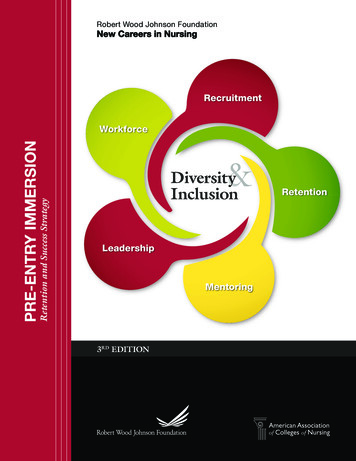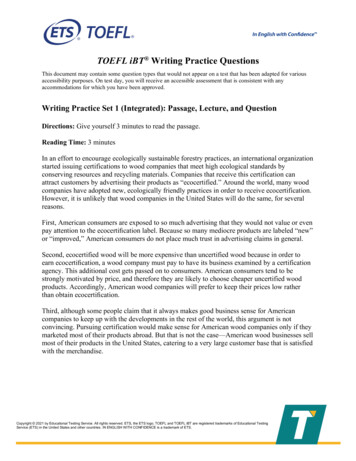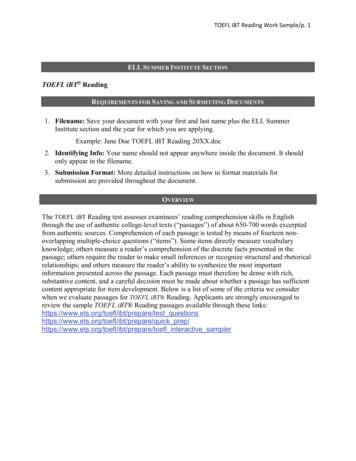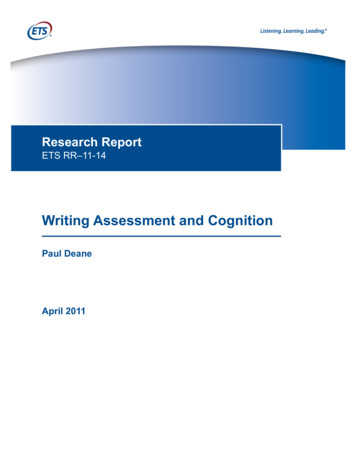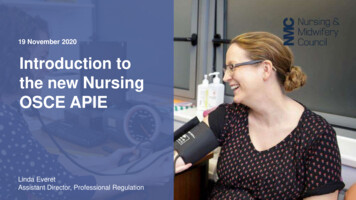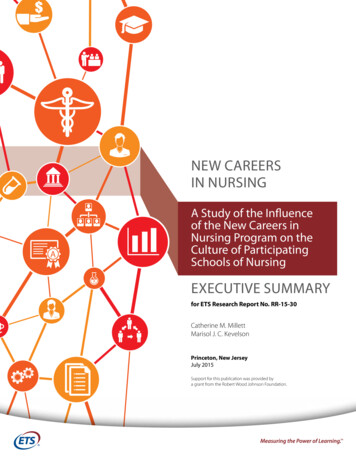
Transcription
NEW CAREERSIN NURSINGAA Study of the Influenceof the New Careers inNursing Program on theCulture of ParticipatingSchools of NursingEXECUTIVE SUMMARYfor ETS Research Report No. RR-15-30Catherine M. MillettMarisol J. C. KevelsonPrinceton, New JerseyJuly 2015Support for this publication was provided bya grant from the Robert Wood Johnson Foundation.
Executive SummaryIn 2008, the Robert Wood Johnson Foundation (RWJF), in partnership with the AmericanAssociation of Colleges of Nursing (AACN), launched the New Careers in Nursing (NCIN)program to urge schools of nursing to intentionally diversify their nursing programs,among other goals. AACN serves as the NCIN program’s national program office, chargedwith monitoring and supporting the implementation and progress of the program. TheNCIN program is designed to: help alleviate the national nursing shortage increase the diversity of nursing professionals expand capacity in baccalaureate and graduate nursing programs enhance the pipeline of potential nurse faculty1Through grants to schools of nursing, NCIN provides 10,000 scholarships to collegegraduates who are enrolled in accelerated bachelor’s of science in nursing (ABSN) andaccelerated master’s of science in nursing (AMSN) programs and who are from groupsunderrepresented in nursing or from economically disadvantaged backgrounds.2 Intotal, 130 different schools of nursing received 35.1 million in support to award 3,517scholarships — 2,723 (77%) for ABSM students and 794 (23%) for AMSN students. TheRWJF also provided funding and technical assistance for several initiatives, such asmentoring and leadership development programs, to support NCIN scholarshiprecipients and their peers in accelerated nursing programs.In 2009, RWJF asked ETS to conduct an evaluation of the NCIN program. In the firstphase of the evaluation, we focused specifically on the accomplishments of the NCINprogram. In the second phase of the evaluation, we broadened our work to produce threestudies: a study of teaching and learning activities in NCIN grantee accelerated nursingprograms (Millett, Stickler, & Wang, 2015a); a study of the experiences and plans of NCINalumni (Millett, Stickler, & Wang, 2015b); and a study of the influence of NCIN on theculture at grantee nursing schools, summarized in this report. For the present study, wehypothesized that the various activities of the NCIN program were influencing the cultureat the grantee schools of nursing.12Source: http://www.newcareersinnursing.org/about-ncin (Robert Wood Johnson Foundation, 2013b)T he eligibility requirements for the NCIN program include membership in a group that is underrepresented in nursing ora disadvantaged background (e.g., economically disadvantaged), U.S. citizenship or permanent residency, a baccalaureatedegree in a non-nursing discipline, and acceptance into an entry-level accelerated nursing degree program for non-nursingcollege graduates.2
To learn if our hypothesis was on point, we proposed to conduct a descriptive multiplecase study examining the implementation of the NCIN scholarship program for thestudents and the related technical assistance provided to the schools of nursing. Weconducted campus visits at eight schools of nursing in academic year 2013–14 in orderto learn through interviews with program staff, participants, and other nursing programstudents and alumni how the NCIN program fit into the daily lived experiences of theschool of nursing community. The schools of nursing were selected for the case study sitevisits based on geography, their status as a public or private school of nursing, the typeof NCIN scholarships they awarded, and their funding history over the first six rounds offunding (see Table 1).Table 1: Schools of Nursing Selected for NCIN Case StudyFunding RoundsRegionPublic School of NursingAzusa Pacific University Schoolof NursingDuke University School ofNursingKent State University College ofNursingNebraska Methodist College ofNursing and Allied HealthSouthern Connecticut StateUniversityUniversity of Mississippi MedicalCenter School of NursingUniversity of Rochester Schoolof NursingUniversity of Wyoming Fay W.Whitney School of Nursing123456ABSN hPublicABSNxxxxxNortheastPrivateABSN andAMSNxxxxxxWestPublicABSNxxxxxxSource: ETS New Careers in Nursing Schools of Nursing Case Study.Note: At the time of the school selection, six funding rounds had passed.We acknowledge two important limitations of case study research. First and foremost,it is not possible to generalize the results to the wider population of schools of nursing.The eight schools in this study may differ from the larger corpus of schools of nursing.However, it would have been difficult with respect to resources to carry out the studywith a greater number of sites. Second, we need to acknowledge that our own subjectivefeelings about the NCIN program, based on our deep experience with it, may influenceour analyses and presentation of the findings.3
The findings from the case study visits highlight several ways in which the NCIN programmay have impacted schools of nursing and accelerated nursing program students, including both scholarship recipients and non-recipients. The NCIN scholarships provided critical financial supports for students who received them.In many cases, the 10,000 scholarship funds enabled recipients to complete theiraccelerated nursing program, or to do so without incurring additional debt or endangering their academic performance by working nights and weekends on top ofa full-time course and clinical practicum load. The flexibility to use the funds at theirdiscretion (e.g., for tuition, child care, transportation, etc.) enabled students to meettheir most pressing financial needs during their accelerated nursing program. Students also repeatedly expressed how the scholarship bestowed a sense of pride andconfidence in themselves. However, many scholarship recipients continued to facefinancial challenges and many still accumulated substantial debt in order to completetheir accelerated nursing program. The NCIN program may have helped to increase the diversity of the case study schools ofnursing, and that of all grantee schools. School of nursing deans and directors acknowledged that NCIN’s goal of promoting diversity in nursing education strongly alignedwith their schools of nursing’s goals to promote diversity. The NCIN program resultedin increased enrollment of male nursing students at NCIN schools — well above average male enrollment levels for BSN programs nationwide — which will contribute toimprovements in gender parity in nursing. Progress also was made in the enrollmentof women from underrepresented racial/ethnic groups, with rates that were also wellabove average racial/minority enrollment rates nationwide, an accomplishment thatmay impact the diversity of the nursing field for decades to come. In many of the casestudy schools, increases in diversity led to an increased focus on teaching culturalcompetence3 and addressing the needs of patients from all cultural backgrounds incourse discussions and clinical practice. Yet there remains room for improvement inthis area, both at the NCIN schools of nursing and within the field more generally.Additional work may be needed to incorporate cultural competency training at alllevels of the teaching and learning experience — in-class, clinical, co-curricular, andpeer-peer learning. The orientation, mentoring, and leadership programs developed by NCIN schools of nursinggenerally provided needed additional supports for students. Throughout the seven yearsof NCIN’s existence, schools of nursing used the NCIN toolkits (e.g., orientation, mentoring, and leadership) to either establish new programming elements or to strengthenextant programming. Students described several ways in which the mentoring andleadership programs enhanced their personal development and opened the doors toadditional career opportunities. Program liaisons described how the improvements inorientation programs helped prepare new accelerated nursing students for the rigorsof the programs.3 According to Bettancourt et al. (2002), cultural competence in health care describes the ability of systems to providecare to patients with diverse values, beliefs and behaviors, including tailoring delivery to meet patients’ social, cultural,and linguistic needs.4
The NCIN program activities supported not only the NCIN Scholars, but also other studentsin accelerated and non-accelerated nursing programs at many case study schools. Itseems that NCIN successfully helped the schools of nursing to achieve some aspectsof their missions, particularly those related to diversity and leadership, schoolwide.Across the case study schools, faculty and staff indicated that the orientation, mentoring, and leadership programs will largely be sustained after the NCIN program ends.They most likely will be extended to all students in the accelerated programs, andsometimes in other nursing programs, if they were not already offered broadly. Staffat several case study schools reported that efforts to increase diversity schoolwide willbe continued at their schools of nursing. Schools may also continue to track studentdemographics to assess progress toward diversity goals. As the national program office, AACN was responsive to the needs of the grantee schools ofnursing and supported the sharing of practices. AACN strove to design NCIN programsand toolkits both “for” and “with” the NCIN grantee community, to respond to needsfor additional student supports. To further support grantee schools of nursing, AACNalso convened annual meetings of NCIN program liaisons from each grantee schooland fostered the development of a Scholars Network for past and present scholarship recipients. In addition to documenting the many ways in which NCIN may haveinfluenced the cultures and practices of nursing schools, the findings of the study alsopoint to several recommendations for the nursing field:Recommendation #1: Schools of nursing should aim to build on the progress seededby NCIN in the areas of student diversity, cultural competence training, and studentsupport services. All schools of nursing could utilize the NCIN toolkits to develop orenhance orientation, mentoring, and leadership development programs for students, andto recruit more male and underrepresented minority students into their degree programs.NCIN schools that have successfully made these improvements could continue to enhance their programming to meet student needs and continue recruiting applicants fromdiverse backgrounds, while sharing lessons learned with other schools of nursing throughprofessional associations and publications. All schools of nursing, whether or not theywere NCIN grantees, may want to increase efforts to incorporate cultural competencytraining at all levels of the teaching and learning experience.Recommendation #2: Government and philanthropic organizations supportingthe field of nursing should explore ways to raise funds to support the financial andmentoring needs of accelerated nursing students in order to promote improvementsin the nursing field more broadly. One option to consider would be to advocate forrevisions of federal financial aid rules for second bachelor’s degree students. Anotheroption is a national campaign to fund scholarships and grants for accelerated nursingstudents to ease the financial burden of these fast-paced programs and enable studentsfrom low-income backgrounds to enter the nursing field and break the cycle of poverty.Yet a third option would be for schools of nursing to focus on raising funds specifically tosupport financially needy accelerated nursing students, given the challenges of financingthese short-term programs.5
Recommendation #3: The existing networks of NCIN scholars and program liaisonsshould be sustained and supported, to ensure the ongoing sharing of lessons learned.These efforts would benefit not only individual nursing students, but also schools of nursing and the nursing field, particularly if lessons learned and resources are shared broadlythrough professional nursing organizations.In summary, our case studies of eight NCIN schools of nursing revealed several ways inwhich the NCIN programs may have positively influenced the cultures of schools of nursing and the experiences of individual students, both scholarship recipients and their peers.Our findings highlight the importance of and need for programs to support acceleratednursing program students.www.ets.org/research/perc/ncinCopyright 2015 by Educational Testing Service. All rights reserved. ETS and the ETS logo are registered trademarksof Educational Testing Service (ETS). MEASURING THE POWER OF LEARNING is a trademark of ETS. All other tradmarks are theproperty of their respective owners. 323476
A. 2. Executive Summary. In 2008, the Robert Wood Johnson Foundation (RWJF), in partnership with the American Association of Colleges of N
